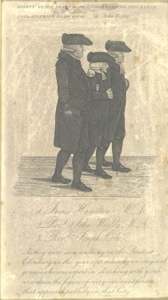Evangelist John Wesley was a walker. He called walking the “best exercise for those who are able to bear it.” On his London walks maybe he encountered his friend and intellectual peer Samuel Johnson, an inveterate walker who routinely strolled 32 miles from Lichfield to Birmingham, and who is said to have had as he walked a “peculiar solemnity of deportment, and an awkward sort of measured step.”
Thomas Jefferson called walking the “best possible exercise” and counseled: “Habituate yourself to walk very far.” He famously walked back to the White House from the Capitol after his inauguration and on Sundays walked to the Capitol for church worship, about a three mile round trip.
“No one knows, till he tries, how easily a habit of walking is acquired,” Jefferson wrote. “I have known some great walkers and had particular accounts of many more; and I never knew or heard of one who was not healthy and long lived.” He typically walked twice a day until old.
George Washington took walks about NewYork as president. John Adams in retirement in Massachusetts walked about the countryside visiting friends and family. Charles Dickens enjoyed 10 mile hikes. Secretary of State John Hay after work routinely walked with historian Henry Adams from Lafayette Square up 16th Street to the then edge of Washington, DC, around today’s Mount Pleasant. Teddy Roosevelt vigorously led delegations of prominent men on straight walks through the wilds of still undeveloped Washington, which required plunging straight through thickets and streams, sometimes stripping naked if the water was deep. In the morning Secretary of State Dean Acheson walked with Supreme Court Justice Felix Frankfurter from Georgetown to Foggy Bottom. President Harry Truman walked two miles daily with the Secret Service, at a military clip he learned in World War I, explaining that any distance farther would not help a man his age. Charles de Gaulle at his country home walked several miles twice a day in the woods, always wearing a suit. After the presidency, Richard Nixon walked the streets of Manhattan, sometimes encountering inebriates.
Running has mostly displaced walking as a deliberate exercise. The French media complained of President Sarkozy’s jogging that it was too American and lacked the dignity of de Gaulle’s giraffe-like undulations. I’ve always hated running. In fifth grade I joined a walkathon of 125 miles requiring at least three miles and up to five miles daily. The award was a trophy with a golden foot on top. Ever since I’ve been a walker and for some years have walked at least four miles daily heedless of weather, sometimes up to 8 miles, time permitting. About the longest I’ve done is 12 miles, years ago, in Normandy, from the village Pontorson, to the seaside castle of Mont Saint-Michel. In Northern Virginia where I grew up I often imagined while walking as a boy, and still do picture, landscapes as they appeared long ago, once littered with Civil War encampments, or as woods surveyed by a young George Washington.
Washington, D.C. is one of America’s great walking cities, facilitating walks of many miles that are continuously scenic and relatively safe, without having to cross interstate or endure blocks of warehouses or urban blight. Other enjoyable walking cities are New York, Boston, Chicago, Savannah and Charleston. There’s the French Quarter in New Orleans, Penn Quarter in Philadelphia, and walking to the incline in Pittsburgh. New suburbs, amid subdivisions and strip malls, may offer comfortable living but they are typically boring walking venues. Small, picturesque towns, such as in the Shenandoah Valley, often offer delightful walks.
Walks in the countryside are invigorating but often require careful navigation of narrow rural roads or aggressive trespassing of back country. Land owners must be confronted with friendly confidence, rebutting any suspicion of poaching. I know an elderly but hale historian and Iwo Jima veteran who investigates ancient colonial road sites through fields and forests. He mollifies questioners with his age and historical explanations. Once he came upon President Bush’s controversial FEMA director, “Brownie,” who was interested to learn his horse farm was bisected by General Edward Braddock’s infamous road to disaster. Country people don’t walk and often will stop to ask walkers if their car has broken down.
As crime recedes, new neighborhoods in Washington, D.C. are constantly opening for exploration. My walks once were confined to Capitol Hill, Georgetown, the Mall, the downtown business district, and the posh neighborhoods of upper Northwest, like Wesley Heights. But now I freely walk in almost any direction for miles, astounded by the new vitality, restaurants, shops, restored old row houses, and endless numbers of young people in areas previously dominated by drug dealers, vagrants and prostitutes. The city has erected scores of new historical markers explaining neighborhood histories. Every walk offers new education about the past and the fast changing present. Discovering venerable old churches is especially rewarding. And almost every block in the nation’s capital is filled with momentous if often forgotten local or national history.
Sometimes I listen to audio books while walking. But Thomas Jefferson warned:
“Never think of taking a book with you. The object of walking is to relax the mind. You should therefore not permit yourself even to think while you walk. But divert your attention by the objects surrounding you.”
Jefferson was probably right.
No comments yet




